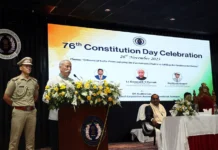Flights Of Fantasy
[ M Panging Pao ]
India and China have had an acrimonious relationship over the last 60 years. The major conflict was the Sino-India war of 1962, when Chinese forces entered almost 100 kms inside India. There have been regular clashes at Nathu La in 1967, Sumdorong Chu in 1987, the 73-day Doklam confrontation in 2017, Chinese incursions in Asaphila, Tuting and Chaklagam areas of Arunachal in 2017-2018, and the recent Sino-India conflict at Pangong Tso lake and Galwan valley in Ladakh. A tense situation exists all along the Sino-India border.
The Chinese still claim Arunachal as ‘southern Tibet’ and issues stapled visas to Arunachal’s citizens. They object to visits by senior Indian officials and ministers to Arunachal and use rivers originating in China to arm-twist India. The source of all these conflicts is the non-acceptance of the McMahon Line which demarcates the Sino-India border along Arunachal.
The McMahon Line demarcates the eastern border between India and China. About 890 kms in length, the McMahon Line followed the watershed principle and runs along the highest ridges of these eastern Himalayan ranges, running from east of Bhutan to the trijunction of India, China and Myanmar.
The McMahon Line was created during the Shimla Agreement of 1914. The British Indian representative was Henry McMahon, the then secretary in the Indian foreign department. The Tibetan representative was Lama Lonchen Shatra and the Chinese representative was a diplomat named Ivan Chen. After almost a year of negotiations, the McMahon Line was initially presented on 22 April, 1914, along with an attached map. On 25 April, 1914, the Chinese submitted a memorandum with a number of objections to the boundaries between inner Tibet and outer Tibet and inner Tibet and China. There were no objections between Tibet and India. Thereafter, on 27 April, 1914, the Chinese representative initialled both the documents and the map without any objections. However, the actual agreement documents were kept secret till 1937, when the McMahon Line was first published in a Survey of India map. In the western sector, the border in the Ladakh and Aksai Chin areas was laid by the Macartney-MacDonald Line.
If the Chinese representative had no objections to the border between Tibet and India and initialled the documents and map during the Shimla Agreement of 1914, why are the Chinese still claiming Arunachal as ‘southern Tibet’? This claim is bogus, hegemonic and not supported by documents and facts.
Having studied Chinese language and hailing from Arunachal, it may be stated that the people of Arunachal, comprising many tribes, are culturally, traditionally and linguistically different from the Chinese.
Considering all these historical facts, the Indian government must run a campaign to rebut the Chinese claims among major nations of the world. The other way to counter the bogus Chinese claims over Arunachal is by putting up prominent voices from Arunachal itself among the major world and national media. It’s time to call the Chinese bluster. (The contributor is retired Group Captain, Indian Air Force)




